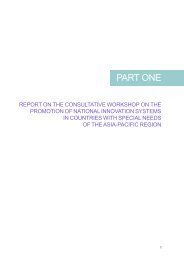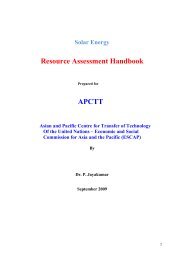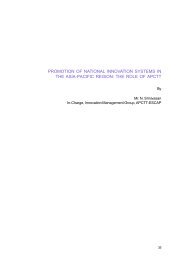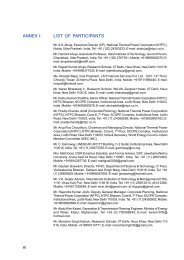IIICONSIDERATION OF ISSUESA. BackgroundIndia’s National Action Plan on Climate Change will take a strategic jump through the12 th FYP, with the government planning to make substantial investments through eightNational Missions – Solar Mission, Mission for Energy Efficiency, Water Mission,Mission for Sustainable Habitat, Mission for Sustaining the Himalayan Eco-system,Mission for Green India, Mission for Sustainable Agriculture and Mission for StrategicKnowledge on Climate Change. The government plans to set up a dedicated structureof governance to oversee different programmes under the 12 th FYP. It already spends2.8 per cent of gross domestic product (GDP) on programmes that bring adaptationbenefits. An expert group headed by Mr. K. Kasturirangan, Member of PlanningCommission, has prepared a report that advices the country to commit to emissionmitigation norms only after consultation with all relevant ministries and stakeholders.India’s commitment to reduce energy intensity by 20-25 per cent below 2005 levels by2020 would incur an expenditure of several billions of dollars. The report hasrecommended that a national authority be set up for implementing mitigation activities.It must be noted that the national political coalition constraints have often worked asdampeners, and only very limited efforts have been made for political consensus onpost-Kyoto climate change issues.The Integrated Energy Policy (IEP) of the Planning Commission suggests the followingsteps to reduce GHG emissions from current levels:• Energy efficiency in all sectors;• Emphasis on mass transport;• Active policy on renewable energy;• Accelerated development of nuclear energy and hydro energy; and• R&D for climate-friendly technologies.India’s mining sector has shown a particular weakness in the financial year 2011-12,caused by a combination of the weak coal output growth (negative growth in fourmonths of the year), a sharp decline in natural gas production in the KG-D6 fields andnegative growth in crude oil output in the third quarter of the year. There has beenimprovement in coal output from November 2011 onwards and the electricity sectorhas performed well. With appropriate supportive policy and administrative measures, itis possible to visualize an improvement in the investment rate in the financial year2012-13, notwithstanding difficult conditions in the international financial markets.Infrastructure – such as power, roads, railways, ocean ports and airports – is an areawhere the government can express its role most powerfully. The inadequacy ofinfrastructure availability continues to act as a constraint for the expansion of economicactivity across the country. It is likely that the targets set for 2011-12 in power androads may be achieved. The government must set ambitious targets for the financialyear 2012-13 for both capacity creation in key infrastructure areas and operationalperformance, especially in the coal sector, such that the economy will get an impetusduring the 12 th FYP.6
India has considerable R&D infrastructure in terms of laboratories, human resourceand facilities. With proper planning, support and networking, India has the potential toproduce state-of-the-art technologies. Gaps in FFT can thus be bridged to generateadvanced technologies that offer efficient energy production with reduced GHGemissions.B. Session I: Promotion and development of advanced FFT inIndiaProf. S.S. Murthy, Consultant to APCTT-ESCAP and Professor, Electrical EngineeringDepartment, Indian Institute of Technology (IIT), New Delhi, presented an overview ofadvanced FFT development in India.Climate change concerns: India has a low per capita emission (1.12 tonnes/year)compared with the world average (4.49), China (5.34) and the United States (18.85).The country’s efforts towards climate change mitigation will take a strategic leap in the12 th FYP, with the government planning to invest almost Rs 2,000 billion (US$39.3billion) through eight National Missions.Global and Indian scene: Sub-critical pulverized coal combustion power plants havebeen the backbone of India’s coal power sector. As on 31 July 2011, India’s installedpower generation capacity was 180,358 MW. Overall share of different energy sourcesin this was: thermal 64.28 per cent, hydro 23.13 per cent, nuclear 2.88 per cent andrenewables 10.55 per cent. Meeting electricity demand over the 12 th FYP period willrequire augmenting the existing capacity by about two-thirds to 280 GW by 2017.Low-carbon emission (LCE) technologies: Preferred LCE technologies are: renewableenergy (small hydro, solar, wind and biomass), geothermal, natural gas, coal(including IGCC and CCS) and nuclear.Coal: About 78 per cent of domestic coal production is dedicated to power generation.Continuing shortages should be made up through stepping up domestic productionand through imports (imported coal is more cost-competitive than imported gas).Domestic coal production should be stepped up by allotting coal block to public sectorundertakings and other captive users. In situ coal gasification suggested for depositsat non-extractable depths. Extracting coal-bed methane before and during mining isan option. Coal is intricately associated with pollution and CO 2emissions at 200-250g/kWh, and these levels have to be brought down by deploying CCT.Clean coal technologies: Of the 200 thermal power plants of different sizes andcapacities in India, about 40 per cent are more that two decades old and cause highlevels of pollution. CCT becomes very relevant in such a situation. CCT has differentforms: supercritical steam cycles, gasification, fluidized bed combustion and coalliquefaction. Supercritical technology is in the forefront of CCT. New power plants areset to perform at supercritical conditions of temperature and pressure, increasing theefficiency to 40-50 per cent. IGCC is another option for India, though expensive atUS$1,500/kW compared with conventional technologies (US$750/kW) or supercriticaltechnology (US$1,000/kW). CCS, while being feasible, has not received priority inIndia. Coal mine methane (CMM) is a large undeveloped resource that can reduce7
- Page 1 and 2: ADVANCES IN FOSSIL FUELTECHNOLOGIES
- Page 3 and 4: ADVANCES IN FOSSIL FUELTECHNOLOGIES
- Page 5 and 6: CONTENTSABBREVIATIONSiiiPART ONEREP
- Page 7 and 8: ABBREVIATIONSAC : Alternating curre
- Page 9: OECD : Organization for Economic Co
- Page 12 and 13: IORGANIZATION OF THE WORKSHOPA. Bac
- Page 14 and 15: D. Election of officersThe followin
- Page 18 and 19: emissions. Underground coal gasific
- Page 20 and 21: 800 MWe, a steam pressure of 300 kg
- Page 22 and 23: • Materials development & manufac
- Page 24 and 25: Figure 1-5: Strategy for commercial
- Page 26 and 27: tonnes, the state-owned enterprise
- Page 28 and 29: • Ensuring not just easy FDI entr
- Page 30 and 31: MW ultra-supercritical units; and s
- Page 32 and 33: the captive generation capacity) on
- Page 34 and 35: and other financial institutions -
- Page 36 and 37: and higher efficiency power generat
- Page 38 and 39: energy technologies, which can enab
- Page 40 and 41: • Such massive financial inputs c
- Page 43 and 44: BASELINE REPORT ON FOSSIL FUEL TECH
- Page 45 and 46: B. General R&D climate in the count
- Page 47 and 48: a convenient way to envisage energy
- Page 49 and 50: to mature and become more cost-comp
- Page 51 and 52: emissions, at least relative to sin
- Page 53 and 54: The Ministry of Power (MoP), which
- Page 55 and 56: 3. Bio-energyBio-energy, widely ava
- Page 57 and 58: in such a canal will rotate at a lo
- Page 59 and 60: in tackling climate change. A one p
- Page 61 and 62: Advantages of supercritical plants
- Page 63 and 64: existing power plants but also to b
- Page 65 and 66: BASELINE REPORT ON FOREIGN DIRECT I
- Page 67 and 68:
CEA at 598 mt. This is mainly due t
- Page 69 and 70:
For India to maintain its momentum
- Page 71 and 72:
Table 2-5: Electricity generation t
- Page 73 and 74:
Growth, which submitted its interim
- Page 75 and 76:
3. Future challengesThe future chal
- Page 77 and 78:
development worked out. Public-priv
- Page 79 and 80:
Linking FDI to technology transferI
- Page 81 and 82:
The total requirement of fund durin
- Page 83 and 84:
Funding from multilateral agenciesM
- Page 85 and 86:
cooperation will be essential in so
- Page 87:
Planning Commission, Government of
- Page 90 and 91:
ANNEX I:LIST OF PARTICIPANTSMr. A.K
- Page 92 and 93:
Mr. S.C. Shrivastava, Joint Chief (
- Page 94 and 95:
ANNEX II:PROGRAMME6 June 2012, Wedn
- Page 96 and 97:
ANNEX III:AN OVERVIEW OF ADVANCED F
- Page 98 and 99:
• Technology solutions are also v
- Page 100 and 101:
Table 3-5: Improvement in cycle eff
- Page 102 and 103:
• No liquid effluent formation;
- Page 104 and 105:
Figure 3-5: Advancement of gas turb
- Page 106 and 107:
Figure 3-8: Goal 2 - New clean tech
- Page 108 and 109:
Compared with conventional power pl
- Page 110 and 111:
Figure 3-14: Thermax coal gasificat
- Page 112 and 113:
ANNEX VII:GE ENERGY AND ADVANCED FO
- Page 114 and 115:
ANNEX VIII:SWOT ANALYSIS OF FOSSIL
- Page 116 and 117:
By 2035, cumulative CO 2emissions f
- Page 118 and 119:
• Falling prices of renewable ene
- Page 120 and 121:
Figure 3-20: New advanced coal powe
- Page 122 and 123:
ANNEX X:ENERGY CONSERVATION: ERDA
- Page 124 and 125:
Table 3-11: Energy cost and intensi
- Page 126 and 127:
300Figure 3-23: Trends in coal use
- Page 128 and 129:
C. Gaps in coal use efficiencyFigur
- Page 130 and 131:
ANNEX XII:FINANCING OF THE POWER SE
- Page 132 and 133:
With the entry of many private sect
- Page 134 and 135:
for future requirements should be t
- Page 136 and 137:
Short supply of coal has started af
- Page 138:
Figure 3-35: Life-cycle of technolo







